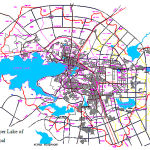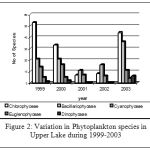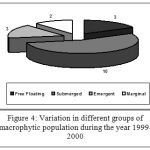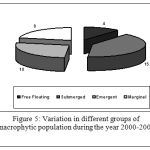Manuscript accepted on :November 30, 2009
Published online on: 18-11-2015
Plagiarism Check: Yes
Vandana Magarde¹, S. A. Iqbal², Subrata Pani³ and Neelofar Iqbal²
¹Department of Chemistry, Rajeev Gandhi College, Bhopal - 462 039 India.
²Department of Chemistry, Saifia College of Science and Education, Bhopal - 462 001 India.
³Lake Conservation Authority of Madhya Pradesh, Bhopal - 462 016 India.
Abstract
There has been growing concern all over the world on conservation of the fresh water biota since most of the fresh water bodies are suffering from threats of pollution due to over exploitation and human interventions. Unfortunately in most of the tropical countries due to rapid and unplanned urbanization, a large number of water bodies are subjected to high degree of nutrient enrichment, resulting in deterioration of water quality including bio-diversity of the lake. Bhoj Wetland (a Ramsar site) constructed in the 11th century, is one of the important wetlands of India, which has been subjected to severe degree of pollution. Thus to restore the water quality of the wetland several conservation measures have been implemented under ‘Lakes Bhopal Conservation and Management Project’ during the year 1998-2004. De-silting, diversion of sewage inflow, catchment area management and removal of various types of weeds are some of the activities that have been executed under the conservation programme. Since all these activities could influence the composition of flora and fauna of the lake, therefore present work was undertaken to assess the impact of all the activities on the biotic components of the lake. Data collected on different physico-chemical and biological parameters during the period of implementation and the impact of various developmental activities on biological characteristics is presented in the paper.
Keywords
Nutrient; De-weeding; Central Indian wetlands; Flora & Fauna
Download this article as:| Copy the following to cite this article: Magarde V, Iqbal S. A, Pani S, Iqbal N. Impact of Developmental Activities on Bio-Diversity of a Central Indian Wetland: Lesson Learned. Biomed Pharmacol J 2009;2(2) |
| Copy the following to cite this URL: Magarde V, Iqbal S. A, Pani S, Iqbal N. Impact of Developmental Activities on Bio-Diversity of a Central Indian Wetland: Lesson Learned. Biomed Pharmacol J 2009;2(2).Available from: http://biomedpharmajournal.org/?p=863 |
Introduction
Conservation of bio-diversity in urban water bodies has become a serious cause of concern since most of the fresh water bodies are suffering from various degree of pollution. Although life exits in all spheres of the earth i.e. land, air and water, water probably supports largest varieties of life in the form of various habitats such as marine as well as freshwater including lake, reservoirs, river, wetlands etc. The wetlands are considered to be one of the richest sources of biodiversity owing to the complex ecological character. Unfortunately the biodiversity of most of the tropical countries in recent years have seriously been affected due to various anthropogenic activities resulting in excessive growth of algal bloom [1].
The Upper Lake of Bhopal is a typical example of urban water bodies, which has been under severe stress of pollution due to inflow of sewage and agriculture runoff [2]. In order to restore the water quality of the lake several measures have been implemented under ‘Lakes conservation and Management Project’. De-silting, prevention of sewage inflow and removal of various types of weeds are some of the activities that have been executed as part of the restoration measures. Since all these activities could influence the composition of flora and fauna of the lake, present work therefore undertaken to assess the impact of all the activities on the biotic components of the lake.
Description of the study area
The Upper Lake of Bhopal commonly known, as Bhoj Wetland (Fig-1) is one of the typical examples of urban lake ecosystems. The wetland has been declared as a Ramsar Site by the Government of India because of its rich biodiversity [3]. The Upper Lake with an age of 1000 years was created in the 11th century basically to supply potable water for the city dwellers. Presently besides being a major source of water supply, the lake is also used for fish culture and eco- tourism.
 |
Figure 1:
|
With time, as the urban pressures grew enormously, intense activities of anthropogenic pressure in and around these Lakes resulted in the deterioration of the quality. The health of this lake is severely affected due to increase nutrient load from point and non-point sources [4].
Materials and method
Under the integrated conservation plan, monitoring of water quality was one of the regular activities. For this, water samples were collected from 18 sampling points from different depths at monthly intervals during the period 1999-2002 to assess the impact of developmental activities on various physico-chemical and biological properties of the lake. Collection and enumeration of plankton samples was done following the standard method [5]. Both qualitative and quantitative analyses were done using Sedgwick Rafter counting chamber under Lieca Image analyzer (DM 400). Samples were identified with the help of keys and monographs [6]. Macrophytes were collected in polythene bags using 1square meter wooden quadrate. Samples were then sorted in the laboratory and identified using keys and monographs.
Results
Variation in number of species of phytoplankton population in Upper Lake during 1999-2003 is shown in Fig 2.
 |
Figure 2:
|
The Upper Lake of Bhopal is traditionally a rich source of phytoplankton. During the year 1999 when the conservation measurers were about to be implemented, total 94 species were recorded in the lake. This was reduced to 71 during 2003. Although no significant reduction in total number of phytoplankton species were observed at the end of execution of conservation measures, but a fluctuation in total number of phytoplankton species were recorded during intermittent years. Particularly during the period 2001 and 2002, there was significant reduction in total number of species in almost all classes (Table-1). In general Chlorophyceae was found to be the dominant class during most of the periods except in 2001-2002 when class Bacillariophyceae was found to be the dominating class.
Table 1: Variation in Total number of Phytoplankton species during different years
| 2000 | 2001 | 2002 | 2003 |
| 33 | 7 | 8 | 34 |
| 21 | 11 | 16 | 19 |
| 16 | 7 | 6 | 12 |
| 5 | – | – | 4 |
| 2 | – | – | 2 |
| 77 | 25 | 30 | 71 |
Table 2: Variation in Total number of Zooplankton species during different years
| Class | 1999 | 2000 | 2001 | 2002 | 2003 |
| Protozoa | 6 | 5 | 4 | 2 | 2 |
| Rotifera | 9 | 12 | 5 | 8 | 8 |
| Cladocera | 8 | 5 | 4 | 5 | 5 |
| Calanoida | 2 | 1 | 2 | 1 | 1 |
| Copepoda | 1 | 4 | 3 | 1 | 1 |
| Ostracoda | 3 | 2 | 4 | 3 | 3 |
| Total | 29 | 29 | 21 | 20 | 20 |
Zooplankton population recorded at Upper Lake was mostly of cosmopolitan nature. The lake usually harbours large and varied number of zooplankton species [7]. However during the period of study a decline in total number of species was observed as the number of species reduced from 29 during 1999 to 20 in 2003 (Table 2). During this period, rotifers were found to be more dominant over other groups. Increase of water-spread area through peripheral dredging of the lake might be a reason for dominance of the groups.
 |
Figure 3:
|
 |
Figure 4:
|
 |
Figure 5:
|
The shift in dominance from protozoan to rotifer during the course of investigation can also be attributed to significant reduction in protozoan species. The reduction in number of species of protozoan communities reflects that there has been an improvement in the quality of water while implementing the conservation measures.
In Upper Lake most of the macrophytes are recorded in the northern region of the lake. Total 37 species of macrophytes belonging to four groups were observed during the year 1999-2000 (Fig 4).
However in subsequent years i.e. during 2000 – 2001 the entire vegetation composition was changed due to de-weeding and dredging operation at different places and total number of species reduced to 18 (Fig 5). Succession of new species was observed at those places where these operations were carried out. Particularly dominance of submerged species like Nitella sp and Chara sp were observed. These areas in previous year usually occupied with Najas minor and Hydrilla verticillata. Although significant quantities of weeds (including free floating and submerged weeds) had been removed and this would have helped in offloading of authocthonus materials during deweeding operation but there were also loss of some endangered species like Utriculari sp. More over the number of species that depicts typical characteristics of wetland vegetation (e.g. Scirpus royeli) and help in preventing soil erosion have also been greatly affected.
Discussion
Upper lake besides being a rich source of biodiversity is also a major source (about 35% of water supply is done) of potable water to 1.5 million city dwellers. However, rapid urbanization in last two decades coupled with increased anthropogenic activities on and around the lake has affected the quality of water to great extent [4]. Thus to restore the quality and to increase the water holding capacity of the lake, several mitigative measures have been implemented through Lake Bhopal conservation and management project. Along with the implementation of these activities, regular water quality monitoring was also included as an important component to understand the impact of the developmental activities on the quality of the water including their affect on the biotic components like phytoplankton and zooplankton, macrophytic community of the lake.
In Upper Lake when the restoration measures were implemented (i.e. during 2001-2002) there was loss of habitat due to removal of macrophytes as well as removal of significant quantity of lake sediment. Beside this, a substantial part of the lake was exposed for a significant period due to scanty rainfall. All these factors together might have affected the overall species composition of the lake. However, during 2003 there was a recovery in total number of species as the total number of phytoplankton species recorded increased up to 90 species. Besides being a change in the number of phytoplankton species, there has been a change in species composition during the period 1999-2002. In 2002 total 8 species of Chlorophyceae was recoded as against 53 observed during 1999 while there has been slight reduction in the class Bacillariophyceae where the number of species recoded (21) during 1999 reduced to 16 species. Although there has been succession in species composition in all the class but the Chlorophyceae was observed to be mostly affected during the period of implementation of various sub project activities. Impacts of developmental activities were also observed on zooplankton community structure of the lake.
Like phytoplankton assemblage, zooplankton structure and function are also controlled externally by both higher and lower trophic levels (Fish predators and algal food) and internally by plankton predators. The decline in number of species may also be attributed to the change of algal composition during the implementation of de-silting and dredging activities and simultaneously introduction of about 3.2 million fingerlings of Indian major carps (Labeo rohita, Catla catla and Cirrhinus mrigala) and Grass carp (Ctenopharyngodon idella). Introduction of fish fingerlings particularly that of grass carp was also aimed to control the luxuriant growth of macrophytes.
The macrophytic vegetation is an important component of primary production in aquatic ecosystem. They provide supports, shelter and oxygen to other organisms and play an important role in productivity. These communities accumulate large aquatic of inorganic nutrients early in their growth season and thereby compete with phytoplankton for nutrient requirements. Although they contribute significantly towards oxygen production but their over abundance (weeds) not only poses serious problems for the development of fisheries, but also to other uses of water and to public health. Therefore under the de-weeding activities, periodical removals of weeds were also done to improve the water quality of the lake. While implementing the de-weeding program, several factors were taken into consideration so as to have minimum impact of the de-weeding activities on the biodiversity of the lake. However as a result of weed removal, successions of few species were observed. This could be related to the alteration of nutrient status of the lake as a result of uprooting of the weeds. The removal of weeds also had temporarily affected the lake biota. At the end of the implementation of conservation measures as the system gradually stabilized, there has been increase in the species diversity [8].
Acknowledgement
The first author is grateful to Chief Executive Officer, Lake Conservation authority of Madhya Pradesh for the support and consistent encouragement for conducting this study.
References
- Pani S & Wanganeo A. Biomanipulation study to evaluate the role of crustacean filter feeder in controlling Microcystis aeruginosa, Asian Journal of Microbiology, Biotechnology and Environmental Sciences, 2-3 (2002).Bajpai A., Bajpai A.K, S.Pani & Misra S.M, Pollution and Trophic Status indicator species of Bhoj Wetland, Env. & Cons., 7 (3): 245-249 (2001)
- Misra S.M, Pani S, Bajpai A & Bajpai A.K Assessment of trophic status by using Nygaard Index with special reference to Bhoj Wetland, Poll Res., 20 (2): 1-7 (2001)
- Pani S, Bajpai A & Misra S.M Studies on Bioaccumulation of Selective Heavy metals in a Tropical Ecosystem, J. Chem. Environ., 6 (1), (2002).
- American Public Health Association. Standard methods for the examination of water and waste water, APHA, 19th Edition, Washington DC (1995).
- Pennak R.W, Fresh water invertebrates of the United States. Protozoa to Mollusca, 3rd Edition, John Willy & Sons,INC, 638 (1989)
- Pani S & Misra S.M Biodiversity and trophic status of two tropical lakes of Bhopal, Proceedings of National Seminar on Biodiversity Conservation & Management with Special Emphasis on Biosphere Reserve held at EPCO sponsored by MOEF (2000).
- Pani S and Mishra S.M Biomonitoring of two different water bodies through macrobenthos, Poll Res., 24 (1) : 23-27 (2005).
- Iqbal S. A., Kataria H. C. and Thakur M. K.; Phytoplankton and Zooplankton population in Upper Lake of Bhopal, National Seminar on Environment, Biodiversity and Conservation held at M. P. Council of Science and Technology, Bhopal (1995)
- Iqbal S. A. and Mohd. Muneer Deshmukh; Study of heavy metal concentration of Halali reservoir water of Vidisha District, Bhopal, Orient J. Chem., 11(3), 290 – 291 (1995)
- Iqbal S. A., Malik Suman and Magarde Vandana; Pollution parameters including Toxic and Heavy Metals contamination studies of Upper Lake of Bhopal (India), World Environ. 1(2): 173 – 175 (2006)
- Iqbal S. A., Kataria H. C. and Chaghtai S. A.; Bacteriological study of Upper Lake of Bhopal (India), Inter., 21(6): 845 – 848 (1995)







